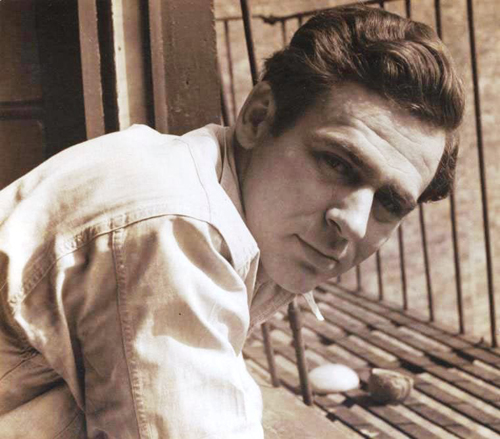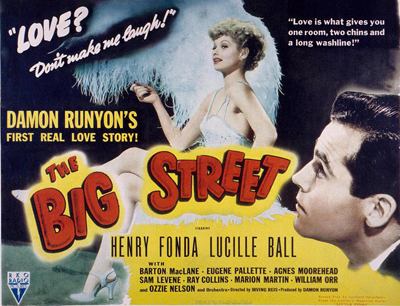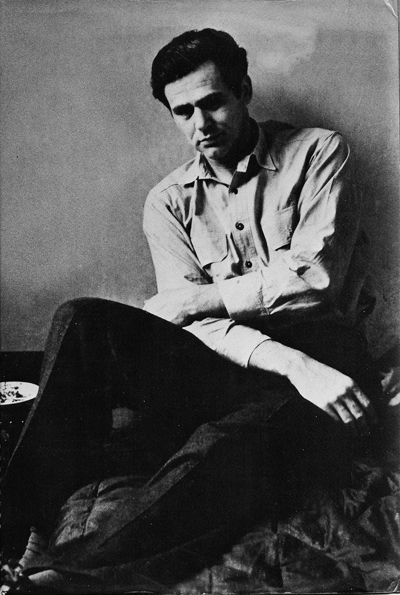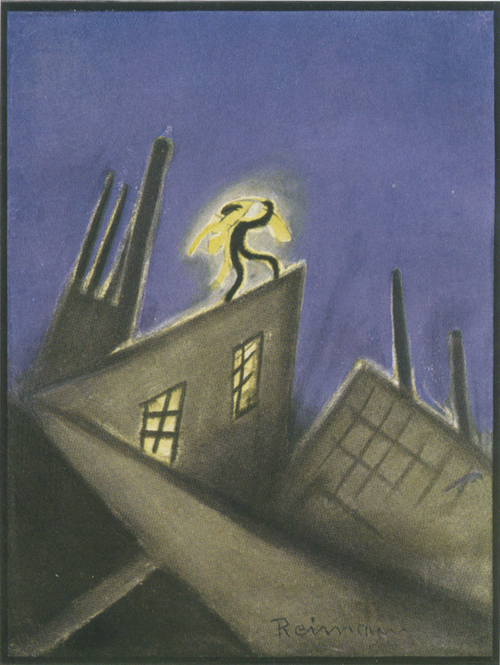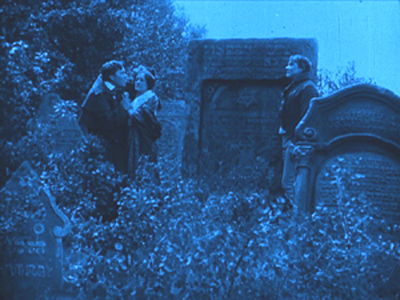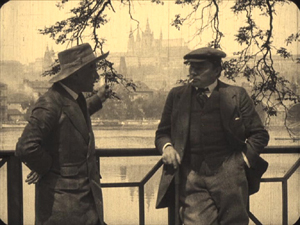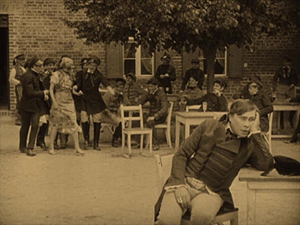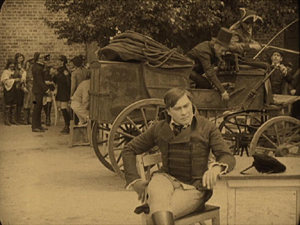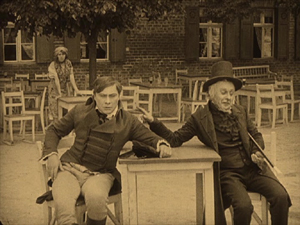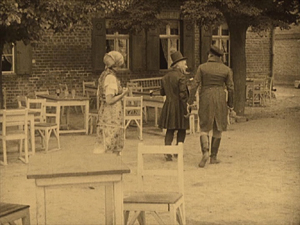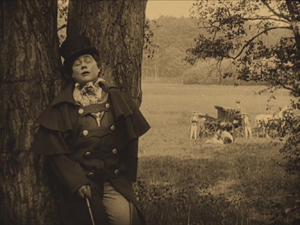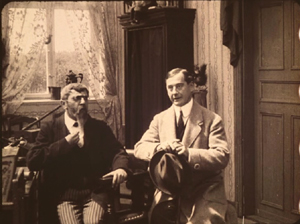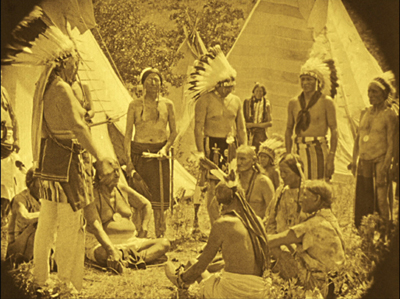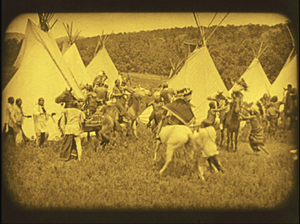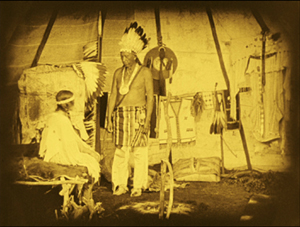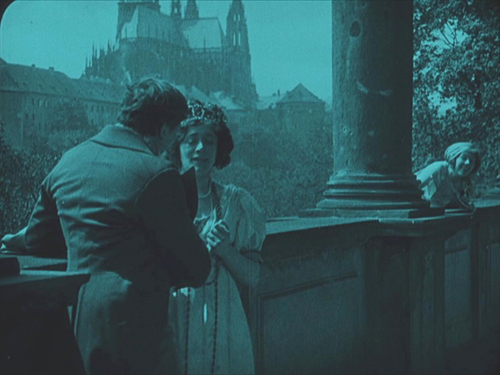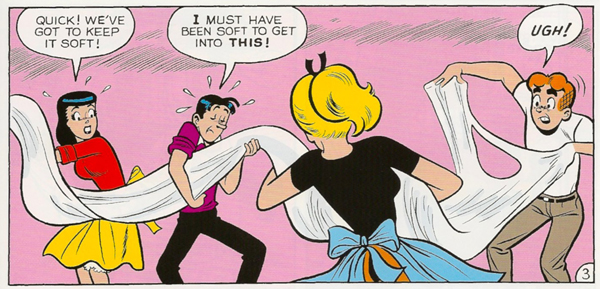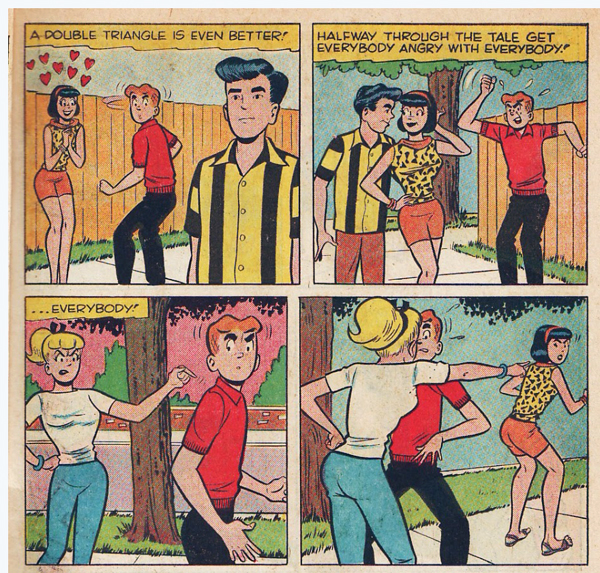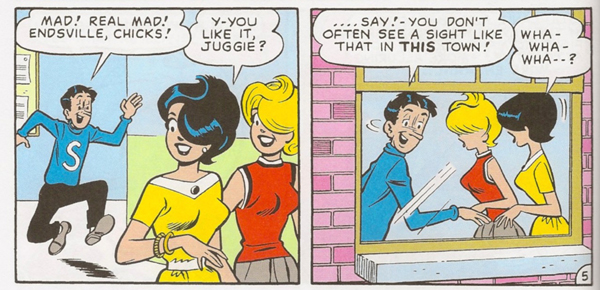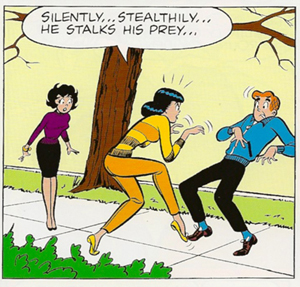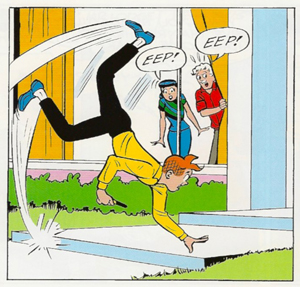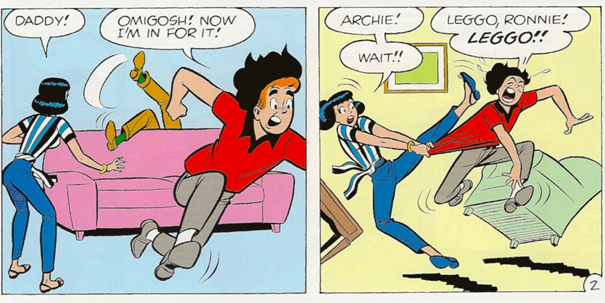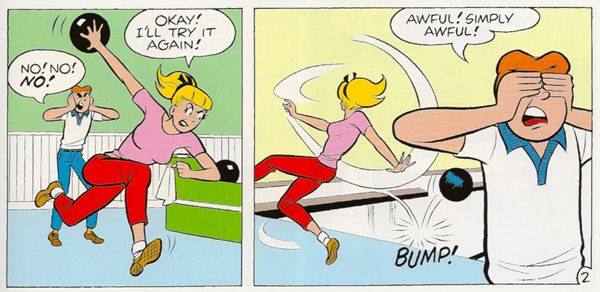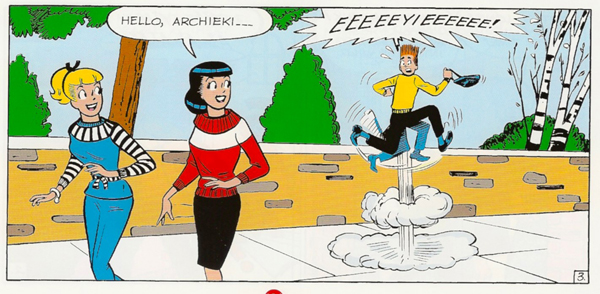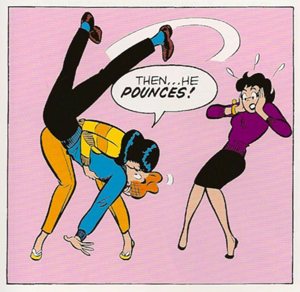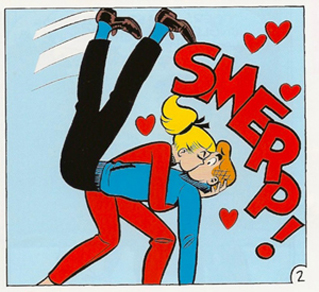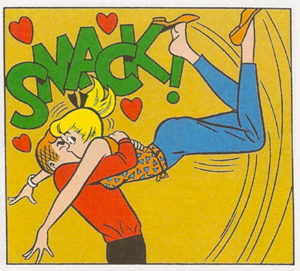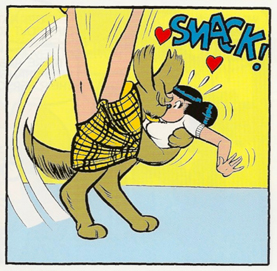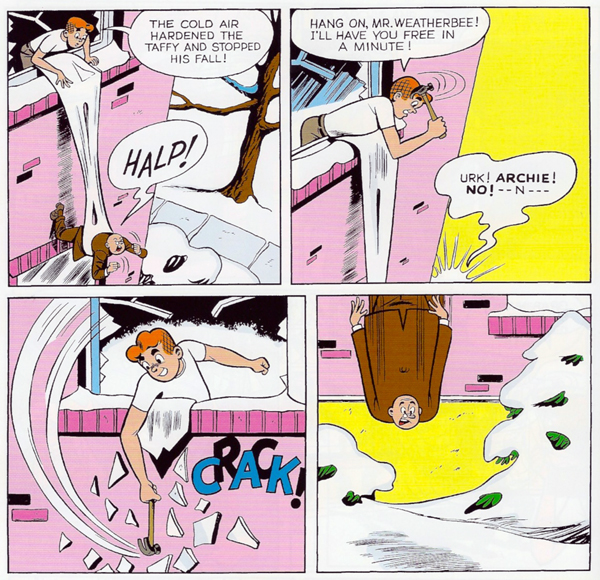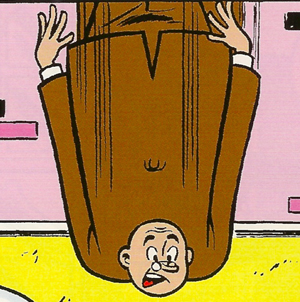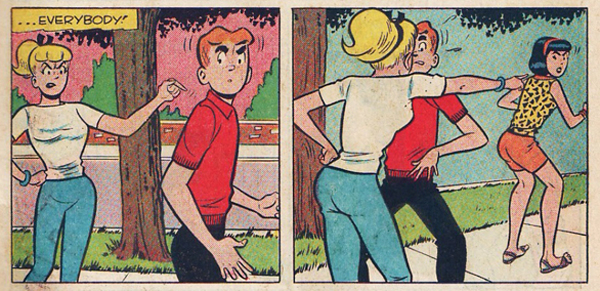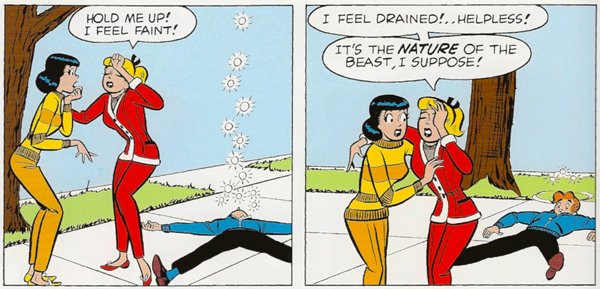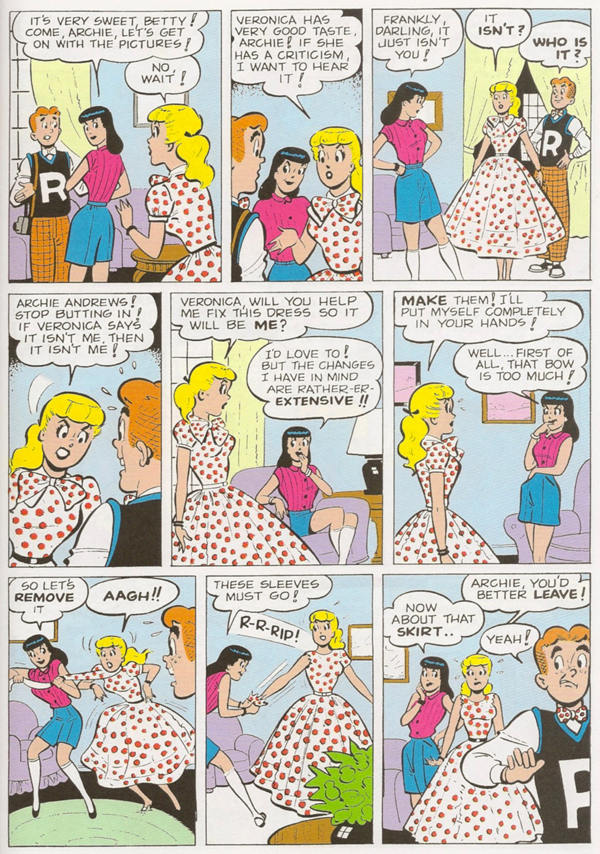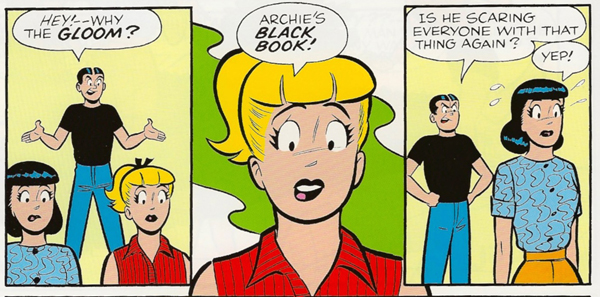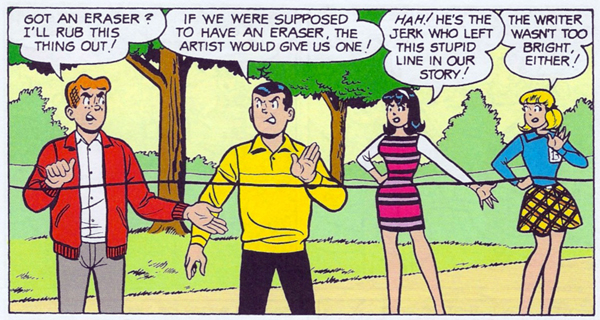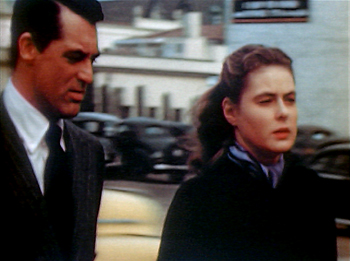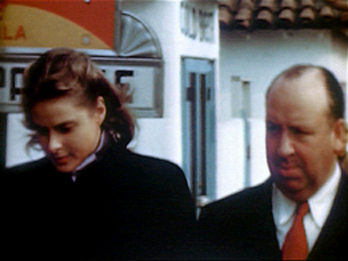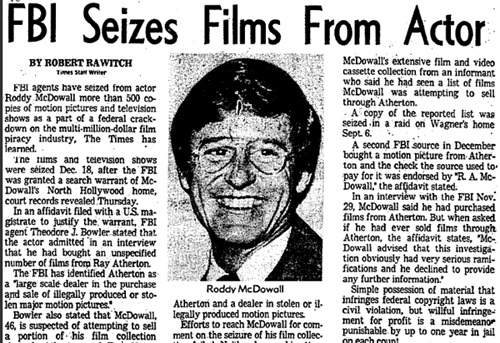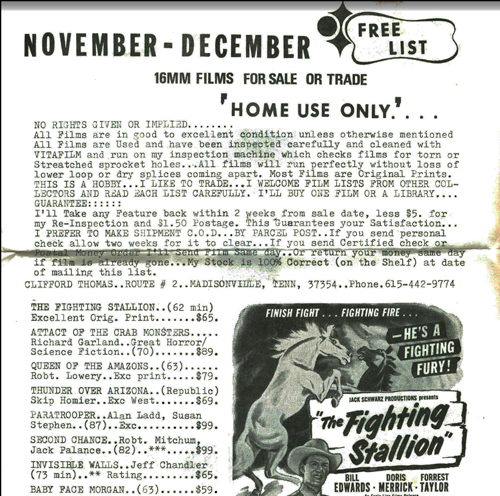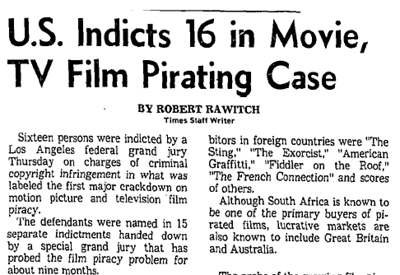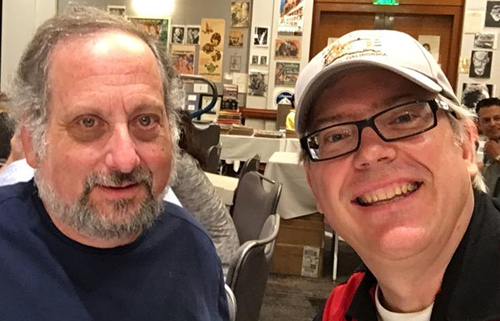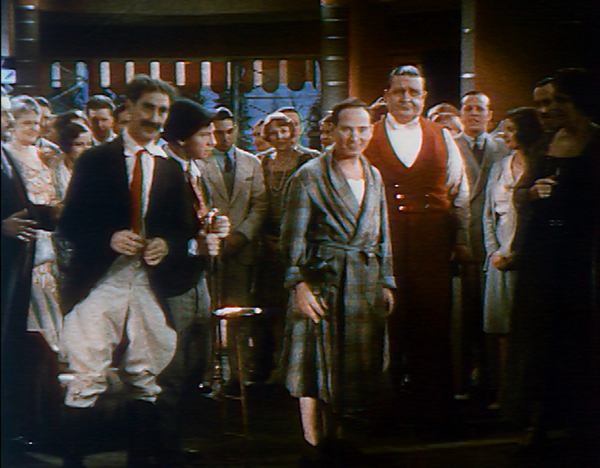Archive for the 'Books' Category
James Agee: Astonishing excellence: A guest post by Charles Maland
James Agee.
DB here: Charles Maland, a distinguished historian of American film, has just completed editing the definitive collection of James Agee’s film writings. It’s due to be published in July.
Agee changed American literature with Let Us Now Praise Famous Men, and he changed film criticism with his reviews for The Nation and Time. After I wrote a 2014 blog entry on his work, I learned of Chuck’s project. Later I decided to turn the entry into a chapter of The Rhapsodes, a study of 1940s American film criticism. Naturally, I turned to Chuck for help. He was magnificently generous, steering me to sources and sharing new material he discovered. In particular, Agee’s unpublished manuscripts contain some powerful arguments and insights. Chuck’s historical introduction to the collection fills in many details of Agee’s relation to popular journalism, to the political and intellectual currents of his time, and to the Hollywood industry.
This book will be one of the most important film publications of 2017. As a warmup, we invited Chuck to write a guest entry on Agee and the process of editing the volume. We’re glad he responded, and we think you will be too.
In the summer of 1927, a precocious seventeen-year-old high school student wrote this to an older friend:
To me, the great thing about the movies is that it’s a brand new field. I don’t see how much more can be done with writing or with the stage. In fact, every kind of recognized “art” has been worked pretty nearly to the limit. Of course great things will undoubtedly be done in all of them, but, possibly excepting music, I don’t see how they can avoid being at least in part imitations. As for the movies, however, their possibilities are infinite—is, insofar as the possibilities of any art CAN be so.
Sixteen years later, British poet W.H. Auden wrote of the “astonishing excellence” of a movie column in The Nation, written by the same person, calling it “the most remarkable regular event in American journalism today.”
Auden was commenting on none other than James Agee (pronounced AY’-jee), a writer that New York Times reviewer A.O. Scott later called “the first great American movie critic.” Acknowledging that Agee didn’t “invent” movie criticism, Scott contends that he did show “what it could be as a form of journalism and a way of talking about the world.”
I concur with Scott about the importance of James Agee’s movie criticism, and for the past several years I’ve been preparing a complete edition of Agee’s movie reviews and criticism. Complete Film Criticism: Reviews, Essays, Manuscripts will appear this July from the University of Tennessee Press as Volume Five of The Collected Works of James Agee. Here I’d like to tell you a little more about who James Agee was and how he became a movie reviewer, what problems I encountered and discoveries I made in compiling the volume, and why Agee’s movie writings still deserve our attention.
Who was James Agee, and how did he become a movie reviewer?
James Agee (1909-1955) was born in Knoxville, Tennessee. In his relatively short career he was a feature writer for Fortune magazine; a book reviewer and movie reviewer for Time magazine; a movie columnist for The Nation; a co-screenwriter of, among others, The African Queen and The Night of the Hunter; and author of a volume of poetry, Permit Me Voyage (1934), an expansive social documentary book called Let Us Now Praise Famous Men (1941), and two novels, The Morning Watch (1951) and A Death in the Family (1957). The latter was published posthumously and won the Pulitzer Prize for Fiction in 1958.
The novel also draws on Agee’s autobiography. When Agee was six, his father was killed in a car accident, and the novel explores just such a situation of a young boy, growing up in the Fort Sanders neighborhood of Knoxville, and the way he and his family cope with the father’s death. In real life, following his father’s tragic death, Agee’s mother sent her son to the St. Andrew’s School, a boarding school in Sewanee, Tennessee. After a year at Knoxville High School, Agee transferred to Phillips Exeter Academy in New Hampshire. There he finished high school and published his first movie review, on F.W. Murnau’s The Last Laugh, which is included in the volume. He then completed his education as an English major at Harvard.
Agee loved movies from childhood. A Death in the Family includes a scene in which father and son walk from their neighborhood to go to the movies in downtown Knoxville, where they see a Charlie Chaplin short and a William S. Hart western. But he didn’t get the opportunity to review movies professionally until the 1940s. His first job as a feature writer for Henry Luce’s Fortune magazine paid the bills.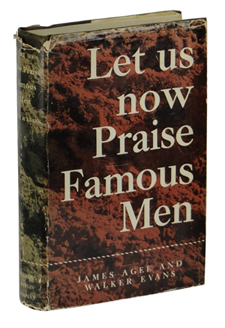
His book on Alabama sharecropper farmers in the Depression, Let Us Now Praise Famous Men, started as an assignment from Fortune, but when Agee discovered that the subject far exceeded the boundaries of a feature article, he took a leave from Fortune to write the book. When it appeared in 1941, Americans were thinking about World War II and it sold only 600 copies, despite some positive reviews. The book’s reputation began to grow during the social turbulence of the 1960s, when it was reprinted and spoke to readers during that era in powerful ways. .
Following that disappointing commercial response, Agee returned to work for Time, Inc., now as a book reviewer for Time. (Volume 3 of the Collected Works, edited by Paul Ashdown, includes all of Agee’s published book reviews and non-film journalism.) While reviewing books, Agee kept alert to openings in the movie section, and he finally got his chance by reviewing The Big Street, starring Lucille Ball and Henry Fonda; the piece appeared in the September 7, 1942, issue of Time.
From then on, he remained on staff at Time as a movie reviewer until November 1948. His reviewing stint was interrupted after he wrote a powerful cover story for Time about the detonation of atomic bombs in Japan. For a few months in late 1945 and early 1946, Henry Luce put him on special assignment to write on social and political topics.
In December 1942, Agee also received an invitation from Peggy Matthews, arts editor of The Nation¸ a left-leaning journal of politics and the arts, to do a regular movie column for that audience. Agee accepted and his first contribution appeared late that month. Agee was writing about movies in two different places until his last Nation column on July 31, 1948. In between, by my best count, he reviewed 561 films in Time and 460 films in The Nation. Of that number Agee discussed 320 titles in both venues.
Agee stopped reviewing because he got the itch to write screenplays. Between 1948 and his death, he sometimes supported himself and his family as a screenwriter. His two most famous credits are on John Huston’s The African Queen (1951) and Charles Laughton’s The Night of the Hunter (1955). (Volume Four of the Collected Works, edited by Jeffrey Couchman, contains the script versions of these two films.) Partly to provide some income after he stopped reviewing but before his screenwriting career gained traction, Agee contracted with Life magazine (another Luce publication) to write extended essays on silent film comedy and John Huston. The resulting pieces, “Comedy’s Greatest Era” and “Undirectable Director,” are familiar to many readers. These pieces, along with some other individual Agee movie essays, like a review of Sunset Boulevard in Sight & Sound, also appear in the collection.
Problems and discoveries
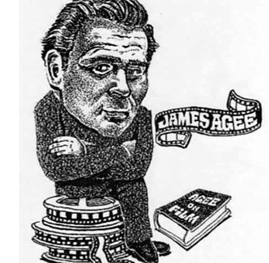 The goal of this Agee collection is to provide access in one volume—for the first time—to all of Agee’s movie reviews, all of his other published articles and essays on movies, and a number of unpublished manuscripts I discovered in my research that cast light on Agee’s movie aesthetic and writing. Nearly all of Agee’s Nation reviews appeared in Agee on Film, Reviews and Essays (1958)—oddly, only his review of It’s a Wonderful Life was omitted—so compiling and editing those reviews was relatively uncomplicated.
The goal of this Agee collection is to provide access in one volume—for the first time—to all of Agee’s movie reviews, all of his other published articles and essays on movies, and a number of unpublished manuscripts I discovered in my research that cast light on Agee’s movie aesthetic and writing. Nearly all of Agee’s Nation reviews appeared in Agee on Film, Reviews and Essays (1958)—oddly, only his review of It’s a Wonderful Life was omitted—so compiling and editing those reviews was relatively uncomplicated.
Only a small selection of Agee’s Time reviews had appeared in Agee on Film. Because I began with what I thought was a full and accurate bibliography of all of Agee’s Time movie reviews, I thought that compiling them would be an uncomplicated task, too. I was wrong.
When he started reviewing for Time, and especially in his last months there, Agee was only one of several movie reviewers (although he was generally the primary reviewer). For the whole period he worked there, Time did not give bylines to writers. To verify what reviews Agee wrote, I enlisted the services of Bill Hooper, Time’s chief archivist. From him I learned that a copy-desk employee would handwrite in one master copy of each issue the name of the author of every article and review. These issues were then bound quarterly, and they eventually were deposited in the Time archives.
Mr. Hooper generously checked each volume against the bibliography I sent him and also responded to a number of questions that arose from the initial inquiry. The only period he was unable to verify was for the first three months of 1946: the bound volume from that period was missing. Fortunately, though, that was the time when Agee had taken an assignment as a special correspondent for social and political affairs.
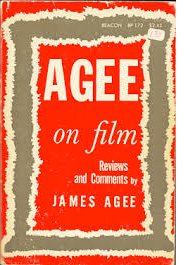 As a result of these inquiries, I discovered that thirteen of the Time reviews and articles included in Agee on Film were in fact written by other journalists. It was even more suprising to discover that all thirteen of those pieces also appeared in the Library of America edition of Agee’s writings, Film Writing and Selected Journalism (2005). Thus, of the 39 film reviews, essays, and profiles included in that volume, Mr. Hooper and I discovered that Agee had written only 26 of them. So I’m deeply indebted to Mr. Hooper. He enabled me to compile all of Agee’s film writings at Time in one place for the first time, at least as close as it is humanly possible to do.
As a result of these inquiries, I discovered that thirteen of the Time reviews and articles included in Agee on Film were in fact written by other journalists. It was even more suprising to discover that all thirteen of those pieces also appeared in the Library of America edition of Agee’s writings, Film Writing and Selected Journalism (2005). Thus, of the 39 film reviews, essays, and profiles included in that volume, Mr. Hooper and I discovered that Agee had written only 26 of them. So I’m deeply indebted to Mr. Hooper. He enabled me to compile all of Agee’s film writings at Time in one place for the first time, at least as close as it is humanly possible to do.
The Agee papers, held principally in the special collections units at the University of Texas and the University of Tennessee, also contained a variety of fascinating information. I learned from financial records that Agee was well paid as a salaried employee of Time and that he was paid modestly at The Nation ($25 a column at first, later—it seems—by the word, which often amounted to less than $25). A few uncashed checks from The Nation in the archives suggest that Agee wasn’t much of a businessman. Other documents contained lists of film screenings that had been set up for Agee; they suggest that he saw a great many films, both in press screenings and regular theatre showings.
Perhaps most interesting for our purposes were a number of previously unpublished manuscripts. They included: 1) four-page typed “Movie Digest,” written in late 1935 or early 1936, containing thumbnail reviews (most with grades—A through F) of films, mostly from 1934 and 1935; 2) a scathing 1938 review of Bardèche and Brassilach’s The History of Motion Pictures that Partisan Review decided not to publish, probably because of how unrelentingly harsh it was; 3) a long letter that Agee wrote upon the request of Librarian of Congress Archibald MacLeish with suggestions about possible films to include in the Library of Congress film collection; and 4) some notes on movies and reviewing, probably from 1949, for a proposed Museum of Modern Art roundtable discussion of movies. All these manuscripts, including several essays or proposals for essays on René Clair and Sergei Eisenstein—both Agee favorites—are included in the collection.
Agee as movie critic
It’s hard in a short space to make generalizations about Agee’s aesthetic and why he should continue to interest us as a movie reviewer. Yet I would say he’s important for at least five reasons.
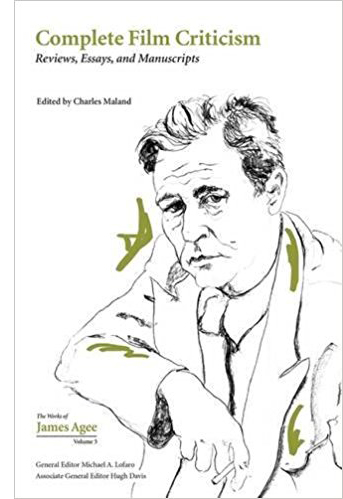 First, grounded in the history of film, he took films seriously and thought they were capable of being great, even though most movies failed to live up to his exacting standards. Beginning his childhood movie-going about the time that Chaplin was becoming an enormous star, Agee came to embrace a pantheon of filmmakers against which he measured other work. That pantheon included silent film comics like Chaplin and Keaton; filmmakers with great ambitions who had difficulty fitting into the system in which they worked, like D.W. Griffith, Erich von Stroheim, and Sergei Eisenstein; and European masters like Murnau, Pabst, Clair, Hitchcock, Dovzhenko, and Dreyer. He also praised a variety of contemporary American filmmakers, including those as diverse as William Wyler, Preston Sturges, Val Lewton, and John Huston.
First, grounded in the history of film, he took films seriously and thought they were capable of being great, even though most movies failed to live up to his exacting standards. Beginning his childhood movie-going about the time that Chaplin was becoming an enormous star, Agee came to embrace a pantheon of filmmakers against which he measured other work. That pantheon included silent film comics like Chaplin and Keaton; filmmakers with great ambitions who had difficulty fitting into the system in which they worked, like D.W. Griffith, Erich von Stroheim, and Sergei Eisenstein; and European masters like Murnau, Pabst, Clair, Hitchcock, Dovzhenko, and Dreyer. He also praised a variety of contemporary American filmmakers, including those as diverse as William Wyler, Preston Sturges, Val Lewton, and John Huston.
Second, his work is historically significant. He began writing just as the film industries of the United States and its Allies were trying to determine the role of movies during the world war that was raging. In his earliest reviews, Agee tended to celebrate the Allied documentaries (what he called “record” films) to the detriment of fiction movies. He was especially sensitive to a kind of poetic realism that he celebrated in Italian Neorealism (in his review of Shoeshine, for example) and in George Rouquier’s Farrebique.
Third, Agee was a magnificent and witty writer. He could write sustained, insightful essays, like his Time cover stories on Ingrid Bergman and on Laurence Olivier’s Henry V or his famous three-part defense of Chaplin’s Monsieur Verdoux. But he was also funny, especially when criticizing a film. Early in 1948 Agee got behind in his Nation reviews when he was hospitalized with appendicitis: to catch up he reviewed as many as 25 films in a single column, often in one sentence or two. Here are a few favorites:
On a mystery film starring Claude Rains, Agee wrote: “The Unsuspected is suspected too soon by the audience and too late by most of his fellow actors.” He disposed of an odd cinematic blend of whodunit and romance with this review: “Embraceable You is dispensable entertainment.” A John Wayne vehicle also took it on the chin: “Tycoon. Several tons of dynamite are set off in this movie; none of it under the right people.” He titled his February 14, 1948 column “Midwinter Clearance.” Perhaps my favorite was a Jeanne Crain-Dan Duryea vehicle: “You Were Meant for Me. That’s what you think.”
Fourth, Agee stands out because he had such catholic tastes. Although he was hard to please, he wrote enthusiastically and positively about a wide range of films. Agee praised European classics like Zero for Conduct, Ivan the Terrible (Part One), Day of Wrath, Children of Paradise, and Farrebique; British films like Henry V, Hamlet, Great Expectations, Odd Man Out, and Black Narcissus; a variety of American movies like The Miracle of Morgan’s Creek, Meet Me in St. Louis, The Big Sleep, The Best Years of Our Lives, Notorious, Monsieur Verdoux, and The Treasure of Sierra Madre; documentary films like Desert Victory, San Pietro, and They Were Expendable; Hollywood B films like Val Lewton’s Curse of the Cat People; the emerging Neorealist films; and dark urban dramas like Double Indemnity that later became known as film noir. Any critic who could write informatively and with enthusiasm about such a broad range of films had to possess a wide-ranging sensibility that welcomed the breadth of artistic possibilities presented by the movies of his era.
I should acknowledge here that some commentators have argued that Agee was not critical enough about really bad films and that he was too equivocal, trying to find something good to say about most of the films he reviewed. I’d respond to these claims in a couple of ways. First, it’s true that Agee was often equivocal in his reviews, but that equivocation often took the form of saying a film could have been more successful if it had done something better, but it didn’t. Another form of Agee equivocation was to say that an otherwise failed film did have some redeeming element (a song, a performance, a stylistically effective moment).
I think the fact that he would sometimes give bad films some positive gesture was partly a function of his love of the movies as an art form. I have to say I’m sympathetic to Agee here. I usually find something redeeming in almost every movie I see, and my wife regularly tells our friends that she’s the true critic in the family—they should ask her, not me, if they should see a film!
Second, I think there’s some difference between Agee’s Nation and Time reviews. He was under tighter editorial oversight at Time, and I think he was under more pressure to avoid completely lambasting a film than he was in his Nation columns. Getting a chance to read all of Agee’s Time and Nation reviews will offer readers an opportunity to think about how he wrote differently about movies for different audiences. The fact remains, however, that of the films and filmmakers he really admired, Agee showered praise on an unusually wide range of different kind of films.
Finally, as David Bordwell has observed, the publication of Agee on Film: Reviews and Essays in 1958 had a strong influence on the growth of film culture in the United States during the 1960s and after. As Bordwell put it,
There’s no knowing how many teenagers and twentysomethings read and reread that fat paperback with its blaring red cover. We wolfed it down without knowing most of the movies Agee discussed. We were held, I think, by the rolling lyricism of the sentences, the pawky humor, and the stylistic finish of certain pieces—the three-part essay on Monsieur Verdoux, the Life piece “Comedy’s Greatest Era,” the John Huston profile “Undirectable Director.” The adolescent fretfulness that put some critics off didn’t give us qualms; after all, we were unashamedly reading Hart Crane, Thomas Wolfe, and Salinger too. Some of us probably wished that we could some day write this way, and this well.
Agee on Film came along at a propitious time: European art film was beginning to flourish and a new generation of critics and reviewers—Sarris, Kauffman, Kael, Schickel, Simon, and later Ebert—engaged with this exciting new film culture. All, at one time or another, acknowledged Agee’s contributions. All, like Agee, published their reviews in book form.
For all these reasons, James Agee’s writings on the movies deserve our continued attention. I hope that by preparing a volume which contains all of Agee’s movie reviews and essays in Time and The Nation, all his other published writings on movies, and a number relevant but previously unpublished essays, I will help enable interested readers to get an accurate and fuller appreciation of Agee’s contributions to our evolving film culture.
Charles Maland is the author of Chaplin and American Culture (Princeton University Press, 1991) and the BFI classics volume on City Lights (2008). We thank him for his willingness to serve as a guest blogger.
Agee’s youthful encomium to film comes from Dwight Macdonald, “Agee & the Movies,” in Dwight Macdonald on Movies (Prentice-Hall, 1969), 3. Auden’s praise of his criticism is in “Agee on Film (Letter to the Editor),” Nation 159, no. 21 (18 November 1943): 628. A. O. Scott’s remarks come from Gerald Peary’s For the Love of the Movies: The Story of American Film Criticism (Bullfrog Films, 2009). The Bordwell quotation is in The Rhapsodes: How 1940s Critics Changed American Film Culture (University of Chicago Press, 2016), 2-3.
Agee’s name was frequently mispronounced. At the end of a 1948 Nation column, Agee apologized for mistakenly calling Amos Vogel “Alex” in a column, then went on to say, “I apologize to Mr. Vogel and to you; and sadly join company with an aunt of mine who used to refer to Sacco and Vanetsi, and with all those who call me Aggie, Ad’ji, Adjee’, Uhjee’, and Eigh’ ggeee’.”
Our next stop: Bologna’s Cinema Ritrovato!
P.S. 1 May 2019: For more on Agee, observed from many perspectives, including Chuck Maland’s, see the commentaries at the Criterion Collection.
James Agee, portrait by Helen Levitt.
Silents nights: Stocking-stuffers for those long winter evenings, the sequel
Kristin here:
A welcome translation, long awaited
From 1991 to 2003, the University of Wisconsin Press published an even dozen books of cinema history in the series Wisconsin Studies in Film. The editorial board consisted of David Bordwell, Donald Crafton, and Vance Kepley, with me as supervising editor. In a little over a decade, we accomplished our simple goal of fostering excellent historical studies in an era when it was far less easy to get such books published than it is now.
Among the dozen was Film Essays and Criticism, a volume of previously untranslated reviews and essays by Rudolf Arnheim (1997). That volume was made possible by the dedication of Brenda Benthien, its translator. Now Brenda has pursued a project she and I discussed long ago. She has brought to fruition a translation of the important classic book, Rudolf Kurtz’s 1926 Expressionismus und Film.
Kurtz’s book has been important enough to warrant two reprint editions in German, one in 1965 by Verlag Hans Rohr, with the illustrations all in black and white and the original cover painting by Paul Leni not used, and another in 2007 by Taschen, edited and with a lengthy essay by Christian Kiening and Ulrich Johannes Beil, as well as the original color illustrations and cover. The English translation, published earlier this year by John Libbey, essentially replicates the 2007 edition, including the cover design and the Kiening/Beil essay. The color illustrations, such as the frontispiece, a design by Walter Reimann for Das Cabinet des Dr. Caligari (top), are also reproduced.
Kiening and Beil are listed as editors here as well. As they point out in their brief introduction to the English edition, there had already been translations into French and Italian, but without the illustrations. Our English version may be late, but it comes much closer to replicating Kurtz’s original.
Kurtz’s title sums up his approach. He defines Expressionism in relation to the other arts of the era, particularly painting and theatre, and discusses the style of six films. Of these, The Cabinet of Dr. Caligari and Waxworks are familiar; From Morn to Midnight, Genuine, and Raskolnikow less so; and The House on the Moon is still, as far as I know, completely lost. (An excellent DVD of Von Morgens bis Mitternacht is available from the FilmMuseum via the link. The Alpha editions of Genuine and Raskonikow are, by report, American cut-down versions with poor visuals.)
One benefit of consulting the original or Benthien’s translation is to reveal that Siegfried Kracauer distorted the famous quotation from designer Hermann Warm that he includes in From Caligari to Hitler: “Films must be drawings brought to life” (p. 68). The original, “Das Filmbild muss Graphik werden” (p. 66 of Expressionismus und Film) is more accurately rendered by Benthien as “The filmed image must become graphic art” (p. 68). “Graphic art,” after all, includes far more than drawings.
The Kiening and Beil essay mentioned above is included in the translation. It is a substantial piece, taking up 75 pages of the book’s total of 214. The authors explain Kurtz’s background in the art world and film industry of the era, as well as discussing conceptions of Expressionism in the years leading up to the release of Caligari. They cite many contemporary theorists’ and critics’s views of of Expressionism in the cinema. Kiening and Beil flesh out Kurtz’s work by pointing out several Expressionist or semi-Expressionist films that Kurtz doesn’t mention. They explain how From Caligari to Hitler and (slightly later) Lotte Eisner’s The Haunted Screen became popular as explications of Expressionist cinema, leaving Kurtz in relative obscurity until recent decades. In short, the essay, entitled simply “Afterword,” is an erudite and invaluable addition to this edition of Kurtz’s book.
Cinematic after all
Way back in 1969, when I was taking my first film class, I saw The Cabinet of Dr. Caligari and became fascinated with German silent cinema, especially the Expressionist movement. I still retain a surprising willingness to sit through German films of the era–even mediocre ones–with their slow pace and heavy acting. Back in those early days, I tried to see the German classics, many of which were available in poor 8mm and 16mm copies.
I vaguely remember being disappointed by my first viewing of The Student of Prague. At the time of that viewing, film studies were still in their early days, and just about everyone assumed that a film was “cinematic” if it had quite a bit of editing and camera movement. The Student of Prague, like many films of its era, was short on both. Its long-take opening shot, with no cut-ins or tracking camera, seemed the epitome of stagy cinema.
I don’t know which version of the film I saw, but it wasn’t the original 1913 one. The film has a complicated history of re-editing and re-release, both theatrically and for home video. This history is recounted in the booklet accompanying the Munich Filmmuseum’s new DVD release of a reconstructed version approximating the 1913 release print, as well as the much shorter American release print. The original version was sold to a producer, Robert Glombeck, who exploited the occasion of the 1926 remake to release the original, highly reworked, including the addition of 107 intertitles. (The original had deliberately been made using a minimal number of intertitles.) Although shortened American and Japanese release prints of the 1913 version survived, the original German one did not.
The new reconstruction has been made from the Glombeck negative, as well as the other release prints, a script, and the incomplete censor’s record. While it cannot claim to be an exact replica of the original, it is far closer than we have had up to now. The excessive intertitles have been removed and a prologue shot showing scriptwriter Hanns Heinz Ewers and lead actor Paul Wegener looking up at Prague Castle restored. (It survived only in the American print.)
Even before this new release, I had gained a far greater respect for this supposedly uncinematic film. My first viewing came before academic interest in early film blossomed with events like The Brighton Project in 1978, trends like the spread of film archives and the rediscovery of many lost prints, and a general recognition of the historical, entertainment, and aesthetic value of early films, even among the general public. Gradually historians had realized that editing and camera movement were not the only techniques that exploited the techniques of the medium. There were long takes and intricate staging. There was the compositional exploitation of depth and the surprises of offscreen space. During the period 1992 to 1998, Yuri Tsivian, Lea Jacobs and Ben Brewster, David, and I explored various techniques that cinema of the 1910s used for expressive purposes. (See the codicil for citations.)
In 1993 I gave a keynote address at the fifteenth IAMHIST conference, “The International Exploration of Cinematic Expressivity, 1913-1919,” at the University of Amsterdam. In it I discussed a wide range techniques of framing, staging, acting, and unusual editing that were innovated in films made in many countries, all tending to enhance expressivity. Among my examples was that opening scene of The Student of Prague. I said, “This seems to me a case that could be dismissed as primitive. Yet it could also be described as a complexly staged scene that sets up the basic narrative situation and uses depth and unexpected appearances from off-screen to heighten the impact of the action.”
Now that we have something approximating the original version, we can look again at that first shot. There are two presentations of the reconstruction in this set, one with a piano rendition of the original score, which survives only in a printed piano score, and one with an orchestration of that score. The piano version runs distinctly shorter, and it looks to be projected at about the right rate. In this presentation, the first shot runs 3 minutes 40 seconds. It contains only two intertitles. After an establishing shot of a beer-garden, our hero enters, and the students hail him as the best fencer among them. This is information that we could only learn through speech. The title also provides his name, Balduin.
He sits glumly, largely ignoring the action behind him as Lydushka (apparently secretly in love with Balduin) enters and the students lift her onto a table for a dance. As this ends, a coach suddenly drives in from the left, and as it blocks most of the background, the students swiftly exit.
Scapinelli gets out of the coach and joins Balduin, tapping him slyly on the shoulder as Lydushka watches, growing anxious as the two start a conversation. The second intertitle provides crucial plot information, as Balduin announces that he is ruined and needs either a winning lottery ticket or a rich heiress. Scapinelli leads him out, the camera reframing slightly with them and with Lydusha, who moves forward to watch them. Soon Scapinelli will appear in Balduin’s room and make the fateful bargain, providing riches and the heiress in exchange for his mirror image.
There is nothing quite like this shot in the rest of the film, but there are some very impressive depth shots. These typically involve a character in the foreground or background looking at other characters. Such shots substitute for eyeline-match cutting, which was not yet a convention of German cinema. In the shot at the bottom of this entry, Lydushka spies on a romantic scene between Balduin and Countess Margit. Below, Balduin realizes that his Doppelganger has killed Margit’s fiancé in a duel, thereby disgracing him.
And there are, of course, the extraordinary shots of Balduin together with his Doppelgänger , achieved by the great German cinematographer, Guido Seeber. When the double, on the right, confronts the lovers in the old Jewish cemetery, the careful staging and double exposure allow Balduin to cross behind the large tombstone and enter the space where his nemesis has been moments before (see the top of this section).
Apart from the different versions of The Student of Prague, the DVD set contains a 1913 short, Die ideale Gattin (“The Ideal Wife”), also “made by” Hanns Heinz Ewers. (The edition treats Ewers as the main creator of The Student of Prague, though most sources credit Stellan Rye as the director. It is true that at the time the scriptwriter was considered the creator of a film, but there’s no clarification of this in the notes.)
This is a charming little comedy starring Paul Biensfeldt as the hero oppressed by his strict, humorless female relatives and in search of a perpetually-smiling wife. Biensfeldt is a familiar face if not name, having played roles in several of Lubitsch’s German features, such as Menon in Das Weib des Pharao. Lubitsch himself plays a small role here, appearing as the matchmaker in only one scene. He is unrecognizable under a wig and beard and has nothing little to do.
The DVDs can be ordered directly from the Edition Filmmuseum shop. I note that Filmmuseum editions are now being sold on Amazon.de as well.
No buffalo were harmed in the making of this film
In March we praised the rescue of a major documentary, Strange Victory, released by Amy Heller and Dennis Doros’ Milestone Film & Video. The company has since brought out a film long thought to be lost, The Daughter of Dawn, one of a handful of fiction features from the decade that used casts entirely made up of Native Americans. (Notable others are Hiawatha [1913], In the Land of the Headhunters [1914], The Vanishing Race [1917], and Before the White Man Came [1920].)
As often happens in such cases, the director of The Daughter of Dawn, Norbert A. Myles, was a white man. He had started as an actor in 1913, directed three features in the 1920s, and went on to a long career working as a makeup artist (usually uncredited) on many of the most famous films of the 1930s and 1940s–most notably Ray Bolger’s makeup as the Scarecrow in The Wizard of Oz.
And as also often happens, the scenario avoids analyzing the culture of the ethnic group in question. The film largely falls back on a very conventional central premise. The film centers around a love rectangle, with the heroine, a Kiowa chief’s daughter nicknamed Daughter of Dawn, in love with the stalwart hunter White Eagle. Black Wolf, a rich brave seeking to become the new chief, spurns the devoted Red Wing and seeks permission to marry Daughter of the Dawn.
There are some action scenes, notably a chase after a herd of buffalo early on. We don’t see any actual killing of buffalo, and although the hunters return to their village announcing success, there is no glimpse of carcasses. Whether this was due to budgetary factors or legal or safety restrictions is unclear. A later battle scene between the Kiowas and some raiding Comanches is more successful. Myles wisely keeps his camera at a distance from most of the action, which creates a sense of genuine combat, unlike the effect of fake-looking close shots of two actors struggling hand to hand.
Still, most of the scenes are devoted to the romance plot, which is rather a pity.
The attraction of the film, though, is its authenticity. Not only did hundreds of Kiowas and Comanches perform for the camera, but they brought their own tipis, costumes, and accessories. They were by this point living on reservations but not so long that they had lost touch with their traditions. The period when the action is set is never specified, but there is no sign of white encroachment, no visible roads, and no mention of the threat of westward-moving pioneers or military. It is as close a look into this vanished past as we are ever likely to have. The Native Americans seem to have been happy to display their heirlooms for the camera, as in this scene where the heroine converses with her father in their tipi.
The performances of most of the cast are predictably rather stiff, with most of them primarily standing or moving where told to by the director. Dialogue titles rather than pantomime handle most of the story information. Myles successfully cast two more natural performers for his leads. Esther Le Barre and White Parker were Comanches (the tribe cast as the villains in the story) but played Kiowas, no doubt because they were both expressive and attractive–though to the filmmakers’ credit, they made no attempt to glamorize the pair.
In short, The Daughter of Dawn is an extraordinary historical document. For more information on the film’s making, rediscovery, and modern release, see the site of the institution that found the surviving print, the Oklahoma Historical Society. Its museum, by the way, has on display the historic tipi used in the film as the heroine’s dwelling. In 2013, after the film was preserved, the Library of Congress added it to the National Film Registry.
I discuss The Student of Prague‘s seminal role in establishing fantasy and horror as key genres that would remain important and culminate in the Expressionist films in “Im Amfang war … : Some Links between Germany Fantasy Films of the Teens and the Twenties,” Before Caligari: German Cinema, 1895-1920, Paolo Cherchi Usai and Lorenzo Codelli, eds. (Edizioni Biblioteca dell’Immagine, 1990): 138-148.
Yuri Tsivian concentrated on the introduction of mirrors into 1910s cinema to create a new way, nontheatrical way of presenting space to the spectator. See his “Portraits, Mirrors, Death: On Some Decadent Clichés in Early Russian Films,” Iris nos. 14-15 (Autumn 1992): 67-83. My 1993 keynote address quoted above was published as “The International Exploration of Cinematic Expressivity,” in Film and the First World War, Karel Dibbets and Bert Hogenkamp, eds. (Amsterdam: Amsterdam University Press, 1995): 65-85. Ben Brewster and Lea Jacobs focused on acting and staging in dept in their Theatre to Cinema (Oxford University Press, 1998). The revised edition is available online.
David began discussing tableau staging and compositions in depth in Chapter 6 of his On the History Film Style (Harvard University Press, 1997) and continued the exploration in the Feuillade chapter of Figures Traced in Light: On Cinematic Staging (University of California Press, 2005). For entries relevant to German Expressionism, check our Ten Best lists and our entries on Homunculus, on Sappho and others, on INRI and others, and on Murnau before Nosferatu.
[November 22: Brenda informs me that she also did the intertitles for FilmMuseum DVD of The Student of Prague.]
The Student of Prague.
Eep, omigosh, urk, smerp, and other Archie epithets
DB here:
Not all cinephiles are comics fans, but quite a few are. I guess it’s partly a matter of the Adolescent Window, and partly an intuition that both are forms of what Will Eisner calls “sequential art.”
For my part, a Boomer childhood spent with Nancy and Little Lulu and Scrooge McDuck was followed by a boyhood fastened on Superman and Batman. Then came the cutoff. I went to college as the Marvel Universe was populating, and I never got into Underground Comix. Only Krazy Kat stayed with me through my college years.
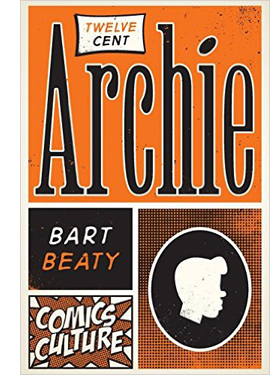 In the 80s Kristin and I followed young talents like Matt Groening, Berke Breathed, and Lynda Barry, while becoming fans of McCay. When I encountered Eurocomics, particularly the Clear Line style and its heirs, I perked up. Joost Swarte (and here) was a special favorite of ours. At about the same time I revisited the old stuff, like Cliff Sterritt. During the 90s and 00s, I tracked the emergence of Ware, Clowes, and other independents.
In the 80s Kristin and I followed young talents like Matt Groening, Berke Breathed, and Lynda Barry, while becoming fans of McCay. When I encountered Eurocomics, particularly the Clear Line style and its heirs, I perked up. Joost Swarte (and here) was a special favorite of ours. At about the same time I revisited the old stuff, like Cliff Sterritt. During the 90s and 00s, I tracked the emergence of Ware, Clowes, and other independents.
Somewhere in all this, Archie abides. I can’t remember when I started reading him, or when I stopped, but he was for me, as for many others, simply and permanently there. Only when I accidentally learned in 2009 that he was to marry Veronica did I go back to him. Finding an interesting variant of the three-roads motif of folklore, I whipped up a blog entry. I added some thoughts about the skillful graphic design of Bob Montana’s 40s work, but in the process I was too dismissive of the later decades chronicling life at Riverdale High.
I realize my error now thanks to Bart Beaty’s wonderful Twelve Cent Archie. It’s a critical and historical study of Archie’s world from December 1961 to July 1969, a period when the comics sold for a princely $.12. That’s also the period, Beaty maintains, when the books’ most skilful writers and artists were at work: Stan Lucey (the Archie titles), Dan DeCarlo (Betty and Veronica), and Samm Schwartz (Jughead). Beaty read every book in the nineteen series, over 900 volumes in all. This admirable undertaking yields funny and enlightening results. It’s one of the best books of comics criticism I’ve ever read.
The Archie Machine
For many of us, Archie is surpassed only by Nancy in the Bland Storytelling Sweepstakes. Archie is a freckle-faced guy on the make, rich girl Veronica alternately two-times him and flies into jealous rages, and Betty pines for Arch from afar. Archie’s rival Reggie tries to gum everything up, while Jughead watches with a mix of scorn and indifference. The plots are filled with deception, misunderstandings, horrible coincidences, and slapstick. Needless to say, the adults—teacher Miss Grundy, principal Mr. Weatherbee, Coach Kleats, Archie’s parents, Veronica’s dad Mr. Lodge—don’t have a clue.
The saga is so cut-and-dried that the makers could publish a story called “How to Write Comics” (1965), in which the moves are laid out with daunting clarity.
These tips remain good advice for plot-making. Had Beaty done no more than unearth this tale, we’d owe him a lot. As ever in popular culture, though, things aren’t so simple. Beaty shows us why.
At one level he embraces the sheer repetitiveness of it all—what he calls the Archie Machine. Oddly, as he points out, Arch is, narratively speaking, null. He can be a good student or a poor one, a clever manipulator or a klutz. Only a few traits, such as his need for money and his innocent lust for vertiginous kisses, persist. Reacting to situations rather than creating them, neither hero nor antihero, he’s more of an unhero, “a blank space on which stories are written.” As a result, there’s little continuity in the stories. If the plot demands Archie to be good in French, he will be, even if previous stories have shown him to be linguistically inept. Besides, as Beaty asks, “Does Riverdale High even have a French teacher?”
The same goes for Riverdale, which despite its name, seems serenely indifferent to its river, which hardly ever appears. There are four seasons, but the topography is fluid, provided with mountains, beaches, forests, and farm fields as needed. This Borgesian landscape reminds you of the Simpsons’ Springfield, but that municipality has landmarks for ready reckoning. Homer always lives next door to Ned, Moe’s bar is always beside King Toot’s Music Store. Beaty points out that in Riverdale, we can’t say whether Veronica’s house is on Archie’s way to school: sometimes it is, sometimes not. “It depends on the needs of the story.” And unlike Springfield, Riverdale is forbiddingly WASP: “a wish-dream of white privilege and normative sexualities.”
Given this mixture of relentless monotony and casual vagueness, the challenge for the writers and artists was to make something interesting. Here’s where Beaty’s book pulls me in: Artists need to solve problems. He shows that his three main artisans created fun and cleverness out of nearly nothing.
I dimly remember thinking, as a kid, that there was more going on in those books than I could understand, but finally, sixty years later, I get a glimpse of it.
Take Betty. Betty isn’t just the lovelorn also-ran. She plots against “best friend” Veronica, pulls pranks to fool the hapless Arch, and generally acts, as Beaty notes, like a stalker. As for Veronica, she can be quite the schemer too. Pictorially, though, they might be twin sisters. “Betty = Veronica,” one of Beaty’s 100 (!) chapters, asks: “Why does Archie struggle to choose between Betty and Veronica when, for all intents and purposes, they are exactly the same person?” Okay, Betty has a ponytail (to which Beaty devotes another chapter), but you take his point. Even when the girls decide to change hairstyles, they wind up looking cloned.
In scenes like this, you have to believe that the creators were having fun with the standard-issue look of our two heroines. Their cookie-cutter similarity allows for ingenious changes in posture, costume, and expression (see below), and can be a source of gags, as here–when their peekaboo hair styles keep them from seeing a pop star’s passing below them.
Silly dialogue that made me snicker still does. Reggie strolls along singing, “I love me, I think I’m grand. When I’m with me I hold my hand.” In the summer I graduated from high school, I don’t think I read the following exchange, but I would have mostly understood it.
Archie, at Betty’s door: “Howdy! I’m a mild mannered reporter for a great metropolitan newspaper!”
Betty: “Come in, mild-mannered reporter! Do something super!”
Archie: “I’ll try!” (Kisses Betty off her feet)
Betty (staggered): “Whew! That’s what I call SUPER, man!”
Betty (recovered, ushering Archie to the door): “Let’s go! I’m not a good first violinist, but I can play second fiddle with the best!”
Archie (serious): “You wound me!”
You wound me?! Denying he’s grabbing Betty on the rebound is an act of supreme callousness. No Superman, Arch. Beaty credits some of the best lines to writer Frank Doyle, source of “I never snapped a whipper in my life.” I wonder if Doyle wrote the oft-reprinted Tiger (1961) with its memorable “A boiling, bubbling volcano flames behind this mild-mannered facade.”
Fun lovin’
Beaty offers so many ideas and observations that I can pause only on the major thing he convinced me of: the fine comic draftsmanship of Harry Lucey. Beaty waxes eloquent on Mr. Lodge’s anatomical twists and turns across a single page. That called my attention to the fact that Lucey drew funny, especially in scenes of manic action. It’s all in the legs and toes, kids.
Who expects contrapposto in an Archie comic? But we get it when Betty goes bowling.
At times we get the classic comic multiple-image stuff that not only cartoonists but animators like Disney and Bob Clampett used in movies. Archie has been spotted carrying his mother’s purse.
As Beaty shows, Lucey excelled at calisthenic clinches and tornado-intensity smooches. When a character, even a dog, kisses another character, he/she/it sweeps the kissee off his/her feet, literally.
Perhaps because the action is often so violent, Lucey can spare a panel that’s a virtual freeze-frame. Any other artist would have wrapped Mr. Weatherbee, plummeting out of his taffy shroud, in a flurry of speed lines, as above. The near-absence of those lines makes the poor man seem suspended forever before his fall.
Actually there are speed lines, but they’re so slight and striated they might be creases in the brown suit. Only the sharpest eye will catch the ones around Mr. Weatherbee’s left wrist.
Thanks to Lucey’s technique, in the same panel the hapless Riverdale principal both falls and hangs suspended.
Hergé likeds to keep his scene’s space clear and consistent, modifying it slightly with “cut-ins” and “pans.” Lucey, like other American comics artists, freely changes angle and even character arrangement to create variety and to point up dialogue. In one pair of panels, the change of angle is bold, slicing off half of Archie’s face to give greater emphasis to Betty’s angry arm-thrust and Ronnie’s reaction on the far right.
A slight change of angle can accentuate background action–below, a flattened Archie raising his head. But Ronnie and Betty have already slid toward the foreground as well.
Characters are freely shifted around the frame, usually in obedience to a left-to-right reading of the balloons. But across a page these spatial reorientations can create a vivacious pattern. Against the mild purple chair, for example, Betty’s scandalous polka-dot dress pops out in each panel while dominating the layout as a whole.
Lucey could do detail too. In any given panel or set of panels, there are little touches that distinguish Betty from Veronica—typically, the lips. Here Betty’s mouth in the second panel seems to catch Veronica’s sideways twist in the first. By the third, Veronica’s mouth has straightened out a little.
Like Archie comics or despise them, but don’t talk about Cathy or Dilbert in the same breath. If you’re a cartoonist, you should be able to draw. If you can infuse your drawing with vivacity, so much the better.
I’ve followed Beaty’s work since his magisterial series, “Eurocomics for Beginners” ran in The Comics Journal in the 1990s. His many books are major contributions to comics scholarship. For sheer pleasure, though, nothing of his I’ve read surpasses Twelve-Cent Archie. It’s at once personal–he recalls his childhood encounter with a cache of Archie books on summer vacation–and analytical in a sympathetic way. Like a lot of good criticism, it opens your eyes while making you smile.
Bart Beaty provides background on Twelve Cent Archie in this interview. A worthwhile review is in The Atlantic Monthly. Beaty talks with indefatigable media analyst and blogger Henry Jenkins at Confessions of an Aca-Fan.
Thanks to Hank Luttrell of 20th Century Books and Bruce Ayers of Capital City Comics for help in finding some Archie stories. Thanks as well to Jim Danky for many long lunches about comics, film, and less important things.
The Archie-marries-Veronica issue I wrote about in 2009 was but the beginning of a long parallel-universe cycle. For a list of the many other revisions in the Archie-verse, see this article. Then there are the Betty and Veronica reboots. The horror cycle, Afterlife with Archie, went in another direction. (And you thought the original kids were zombified.) It’s been a big success. Urk!
In timely fashion, Mad City Movie Guy Gerald Peary has come out with his own contribution, a documentary called Archie’s Betty. He too has reviewed Beaty’s book for The Arts Fuse.
P. S. 23 January 2017: Here’s some fascinating backstory on the “reimagining” or “rebooting” or “reinvention” of the Archie saga. Turns out Forking-Path Archie, which got my attention, was a turning point for the company as well as its protagonist.
Reeling and dealing: Rescuing movies, by hook or by crook
DB here:
There have long been film collectors, and they’re central to film preservation. Some archives, notably the Cinémathèque Française and George Eastman House, were built on the private hoardings of passionate cinephiles. Filmmaking companies, both American and overseas, had little concern for saving their films until home video showed that there was perpetual life in their libraries. By then, many classics had been dumped, burned, or left to rot, and in many cases collectors came to the rescue.
In America, private collecting really took off after World War II. What happened afterward is too little known among cinephiles, but it represents an important part of film culture. A new book fills in a lot of the detail, and in a very entertaining way. It’s a big contribution to our knowledge of the afterlife of the movies.
16 + 35 = $$$$
In the late 1940s, 16mm versions of theatrical releases became widely available. For a while the studios contemplated replacing 3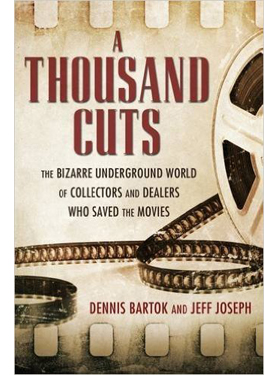 5mm with 16 in regular theatres, but soon the narrow gauge emerged as the format for nontheatrical screenings. Schools, churches, and colleges got war surplus 16 projectors. The Museum of Modern Art circulated classics in the format, and for newer items programmers could turn to Audio-Brandon, Janus, and other distributors.
5mm with 16 in regular theatres, but soon the narrow gauge emerged as the format for nontheatrical screenings. Schools, churches, and colleges got war surplus 16 projectors. The Museum of Modern Art circulated classics in the format, and for newer items programmers could turn to Audio-Brandon, Janus, and other distributors.
Many of those firms dealt in foreign titles, which weren’t as attractive to most collectors—who were in love with Gollywood. For them, the floodgates had already opened when the studios licensed their pre-1948 product to television. The 1950s and 1960s were very unlike the multi-channel 24/7 TV environment of today. The networks didn’t fill the broadcast day, and many independent stations tried to support themselves apart from the nets. So everybody needed what we now call content. Our colleague Eric Hoyt has traced in detail how C & C Movietime and other entrepreneurs bought rights to classics and not-so-classics and packaged them in 16mm bundles for local TV stations. Those prints were shown throughout the day and night, interspersed with commercials cut in by staff like Barry C. Allen.
In the 1950s hundreds of copies of film classics were abroad in the land. But many of these TV prints wound up discarded and scavenged by guys (almost always guys) who wanted to show them at home. Aficionados started building their own libraries.
Collecting 35 was tougher, but it could be done. Older films were stored in labs and depots. They might wind up in Dumpsters or be smuggled out by enterprising employees. Of course showing 35 was more difficult, but it wasn’t impossible to get 35 projectors fairly cheap, and if the hobbyist was willing to make major home renovations, he (again, almost always a he) could set up a personal screening room. Some went with curtains, masking, auditorium seats, popcorn machines, and other amenities. The idea of “home theatres” for ordinary folks has its origin here.
Acquiring 16mm was gray-market but ultimately not very criminal. Because of the First Sale Doctrine, a collector was not in violation if he bought a 16 print that had already been sold (to a TV station). If I buy the new Carl Hiaasen novel Razor Girl, I can sell my copy to you because someone sold it to me. What got 16mm dealers in real trouble was their zeal to copy prints. If they got access to a nice 35, they might make a 16 reduction; or if they had a decent 16, they might pull dupes. These were definitely illegal, as if I were to scan Razor Girl and sell you a pdf.
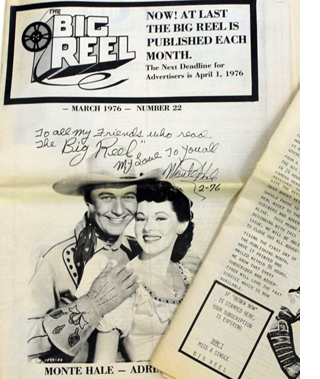 Mimeograph lists circulated by mail, but by the 1970s, collectors had their own periodicals, like Classic Film Collector and The Big Reel. To say that readers subscribed for the nostalgia pieces would be like saying you bought Playboy for the articles. The meat of the issues lay in the dealers’ lists, which might go on for pages. I well remember the rush to the phone after The Big Reel arrived each month. Once I called a Texas dealer who had advertised an untitled Japanese film. He was puzzled by its Irish name: The Life of O’Hara.
Mimeograph lists circulated by mail, but by the 1970s, collectors had their own periodicals, like Classic Film Collector and The Big Reel. To say that readers subscribed for the nostalgia pieces would be like saying you bought Playboy for the articles. The meat of the issues lay in the dealers’ lists, which might go on for pages. I well remember the rush to the phone after The Big Reel arrived each month. Once I called a Texas dealer who had advertised an untitled Japanese film. He was puzzled by its Irish name: The Life of O’Hara.
With some exceptions, 35 prints weren’t originally sold, only rented, and so possession of one suggested, to suspicious minds, big-time theft. Actually, most collectors’ prints had been junked, and you can argue that once something is tossed out, it’s the American Way to scavenge and recycle it.
Beyond the domestic collectors’ market, there was money to be made with 35 prints. American films didn’t circulate much in Cuba, South Africa, parts of Asia, and Eastern Europe, so there was an international demand for bootleg copies, and some dealers were happy to meet it. I lost out on a collection of Hong Kong films that was bought by an Indian dealer who intended to circulate them at home. I always think of that episode when I see the almost inevitable kung-fu fight in an Indian action movie.
The sale of 35 boomed because of another factor. With the rise of the blockbuster mentality in 1970s-1980s Hollywood, the nation was awash in theatrical prints. Then as now, a film might open on thousands of multiplex screens, play a few weeks, and be done. The studio would keep a few of those prints, but the rest would have to be disposed of. Salvage companies were contracted to destroy them, but—human nature being what it is—often some copies slipped out and into eager hands.
Films stored in laboratories or warehouses had a habit of disappearing as well, and prints shipped to theatres might be waylaid. I remember booking Blue Velvet and learning that the copy had disappeared in transit. The fact that prints were labeled with their titles printed in large letters probably didn’t help keep them safe. I was always startled to see the casual ways in which prints were handled. On Thursday midnights I’d leave a screening at one local theatre and see, neatly lined up on the sidewalk, shipping cases bearing the titles of films that had played there in recent weeks, waiting for a UPS pickup the next morning. After a theatrical run, exhibitors cared as little for prints as producers and distributors did.
Many collectors favored older titles, but others were as susceptible to blockbuster mania as general audiences. Star Wars, Jaws, The Godfather, and all the other top hits became as sought-after as Casablanca and Snow White. Collectors still boast of having multitrack, IB-Tech copies of 1970s and 1980s franchise pictures.
Enter the Feds
Los Angeles Times (17 January 1975), B1.
I’ve moved from describing the collectors’ market to describing the dealers’ market. That’s because they were almost one and the same. Collectors needed dealers to help find the rarities they yearned for; collectors started to deal to support their habit; and dealers, whether collectors or not, found that they could make money acquiring and selling movies. Demand and supply, in solid capitalist fashion, created an underworld traffic in prints.
The studios didn’t take this lying down. With the aid of the FBI, they pursued collectors, pressuring them to snitch on their suppliers and fellow addicts. Former child star Roddy McDowall, an avid collector, was the most visible target of these maneuvers. I well remember the chill that passed through the collector community at the news of the Feds’ raid on his house, which turned up hundreds of prints and videos. McDowall, who could probably have won a legal case, gave up many of his contacts. Charges against him were dismissed, but the U.S. Attorney pursuing the case warned that the activities of film collectors (said to number 65,000) “could constitute serious violations of both state and federal law.”
Most collectors flew under the radar, though. Although McDowall’s collection was mostly 16mm, the studios turned a blind eye to 16mm collectors. Famously, William K. Everson helped studios uncover lost films (e.g., obscure Fords and Stroheims) and as payment received 16mm copies of his discoveries. Collectors like Bill, who accumulated several thousand prints, shared their libraries with archives and film schools; at NYU, Bill taught from his collection for many years.
Home video didn’t destroy this underworld right away. The first video systems were of such poor quality that they couldn’t compete with 16mm projection, let alone 35. However, as formats improved in the 1990s, more and more collectors turned to video. Why thread up a battered copy of an MGM musical when a pretty nice DVD could just be popped into your player? With the arrival of Blu-ray, which can look very impressive projected in theatrical conditions, 35 began to be seen as more and more a retro hobby. And your average hobbyist was discovering that he (still almost certainly a he) was aging. Or dying.
The studios mostly lost interest in film-based piracy, once video presented a threat on a much bigger scale. Duplicating VHS and laserdisc, always imperfect, was followed by the cloning of perfect copies of DVDs. Now, of course, the main arena is the Net, where film piracy via BitTorrent has exploded to a level the old-timers couldn’t imagine. Back in the 60s, there were very few film collectors. Now, thanks to digital convergence and massive hard drives, everybody is a film collector—not only he’s.
Boom and busts
This is the world chronicled, with affection, humor, gossipy detail, and a pang of melancholy, in Dennis Bartok and Jeff Joseph’s A Thousand Cuts. Dennis has been head of programming for the American Cinematheque, and he currently heads the distribution company Cinelicious Pics. Jeff was one of the top film dealers in the country; at its peak, his company SabuCat sold about 1,000 prints per month. In the wake of the McDowall bust, Jeff became the only film dealer to serve time for selling prints. Jeff is now a distinguished archivist, conserving 3-D prints and, most recently, rare Laurel and Hardy movies.
The book lives up to its subtitle: The Bizarre Underground World of Collectors and Dealers Who Saved the Movies. Through interviews, documents, and vast knowledge of the world of film dealing, Bartok and Joseph have given us an invaluable survey of a wondrous land. It’s as gripping, and sometimes as hallucinatory, as any Forties B noir.
 Start with the cast of characters. Hugh Hefner, it turns out, was a huge collector, and not just of erotica. Probably today’s most visible collectors are Robert Osborne, of Turner Classic Movies, and the genial Leonard Maltin (right), who has lived in many worlds—fandom, mainstream publishing (thorough books surveying aspects of film history), and mass media (TCM, Entertainment Tonight, etc.). His obsession: shorts and cartoons. Men with an appetite for features include director Joe Dante and producer Jon Davison, whose collections continue to grow.
Start with the cast of characters. Hugh Hefner, it turns out, was a huge collector, and not just of erotica. Probably today’s most visible collectors are Robert Osborne, of Turner Classic Movies, and the genial Leonard Maltin (right), who has lived in many worlds—fandom, mainstream publishing (thorough books surveying aspects of film history), and mass media (TCM, Entertainment Tonight, etc.). His obsession: shorts and cartoons. Men with an appetite for features include director Joe Dante and producer Jon Davison, whose collections continue to grow.
Once we leave behind the celebrities, things take a more exotic turn. There’s Evan H. Foreman, the first collector targeted by the studios, a tough customer who fought for the right to sell prints and was called to testify before a Senate committee. There’s Ken Kramer, proprietor of The Clip Joint, a Burbank archive and screening facility decorated with posters and Christmas lights. There’s Tony Turano, who claimed for years that he was the baby in the bulrushes in The Ten Commandments. Tony kept his apartment heavily curtained, the better to preserve Claudette Colbert’s headdress and robe from Cleopatra (1934). Paul Rayton, projectionist extraordinaire, stores the cans for his rare Oklahoma! print in the back seat of his car. Not the film–it went vinegar long ago. Just the cans.
There’s Al Beardsley, uniformly considered untrustworthy, perhaps because he simply picked up a 70mm print of Lawrence of Arabia posing as a delivery courier and immediately sold it to a collector. Beardsley gave up film dealing for sports memorabilia, and became a participant in the O. J. Simpson throwdown in Vegas. As Beardsley recalls his encounter with one Thomas Riccio, who had set up the O. J. meet: “I had a drink and, I believe, a hamburger that Riccio paid for. He feeds you before he screws you.” O. J. was more direct: “Motherfucker, you think you can steal my shit and sell it?” Yes, firearms were involved.
This is as wild and crazy as any nerd culture can be. Like collectors of comic books and LPs, film mavens are clannish and wily, generous and secretive, boastful and yet somewhat innocent. These guys can’t be considered Geek Chic; they retain an unselfconscious love for what moved them in their youth. They live in the Adolescent Window, as we all do, but they don’t pretend to have become hip. And they run risks that other collectors don’t. A book or record collector runs no risk of arrest. But should a film collector offer a rarity to an archive? Will the studio claim it and bury it? Will the law get involved? Paranoia strikes deep, and justifiably.
Some of the tales are painfully funny, some just painful. This is the sort of book that contains sentences like:
The two were briefly partners as film dealers in the early 1970s, until Ken’s then-wife Lauren left him to marry Jeff, shortly after they were discovered having an affair at the 3rd Annual Witchcraft and Sorcery Convention.
Turano, wheelchair bound, had a habit of bursting into showtunes at the top of his voice. Tom Dunnahoo, of Thunderbird films, “routinely passed out on the floor of his film lab drunk on Drambuie.” A dealer takes pride in the fact that at his trial, the expert on the stand couldn’t tell his dupe of Paper Moon from the original. Another bit of dialogue:
“You remember I had a beet-red print of Giant? Well, Louie Federici ran it and borrowed a beautiful IB print of Giant. Afterward he sent it back to Warners, and you know what they got? A beet red print,” he says, face lighting up.
“You swapped it out?” Jeff asks.
“I did. And later I traded it to you for Singin’ in the Rain. How about that, huh?”
Nearly every page of my copy boasts my penciled ! in the margin.
Saving the movies
Jeff Joseph and Dennis Bartok, Cinecon 2016.
The book stresses that collectors functioned as preservationists. Just as in the early days of archives, they have saved films major and minor from destruction. Just last week, we learned that a collection of 9.5mm has added more footage to a partially surviving Ozu film, A Straightforward Boy. Famously, missing King Kong footage was discovered by a collector. . . and given, not sold, back to the studio. Tony Turano found a missing Fred Astaire number from Second Chorus in Hermes Pan’s closet. Jeff Joseph preserved color behind-the-scenes footage of Animal Crackers and found remarkable home-movie Kodachrome footage of Hitchcock, Bergman, and Grant out for a walk during the shooting of Notorious (surmounting today’s entry). Mike Hyatt has devoted his life to cleaning up The Day of the Triffids. Using a jeweler’s loupe and a needle, across many years, he flicked over 20,000 bits of dirt out of the camera negative.
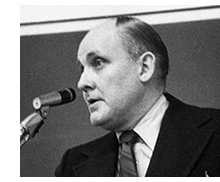 Every collector I’ve known has welcomed sincere interest in their holdings. In pre-video days, Bill Everson (right), unbelievably, loaned prints to undergrads for their papers. Kristin and I spent many nights at friends’ homes screening rare silents and unusual items, like a full-frame print of North by Northwest that showed the edges of the Mount Rushmore backdrop. Nearly every chapter of A Thousand Cuts recalls nights when the collectors would screen their rarities. Cutthroat they might be in dealing, they were often eager to share their treasures with those who’d appreciate them.
Every collector I’ve known has welcomed sincere interest in their holdings. In pre-video days, Bill Everson (right), unbelievably, loaned prints to undergrads for their papers. Kristin and I spent many nights at friends’ homes screening rare silents and unusual items, like a full-frame print of North by Northwest that showed the edges of the Mount Rushmore backdrop. Nearly every chapter of A Thousand Cuts recalls nights when the collectors would screen their rarities. Cutthroat they might be in dealing, they were often eager to share their treasures with those who’d appreciate them.
Most of the stories in the book come from the West Coast, as you’d expect. Other regions have their own lore and characters. The East Coast was a lively scene, centering on Manhattan’s Theodore Huff Film Society (duly noted in A Thousand Cuts) and Bill Everson’s screenings at the New School and elsewhere. Scorsese is, of course, a famous collector. Until this last year hard-core fans of old films gathered at Syracuse’s fine Cinefest. The Midwest had its own center of film trade, Festival Films in Minneapolis, now a source of public-domain items. The screening-and-dealing gathering Cinevent, in Columbus, Ohio, is entering its 49th year.
There were colorful personalities hereabouts too, including a Milwaukee collector with a stupendous array of original Hitchcocks from the 1950s. Another Wisconsin collector, Al Dettlaff, discovered and jealously guarded Edison’s 1910 version of Frankenstein. I met a collector in remote Minnesota who had converted his garage for 35mm screening both indoors and outdoors. He could aim his projectors to shoot out onto the back yard for neighborhood shows (a popular pastime for collectors). During the snowbound winters, he could swivel the machines to shoot through the kitchen to the living room. I asked how his wife felt about sawing holes in the walls. He said: “She’s fine with it. She knows I can get a new wife a hell of a lot easier than an IB Tech of Bambi.”
Dennis and Jeff are to be thanked for recording precious information about a phase of American film culture that has been neglected. They’re continuing the effort with a clip show on 23 September at the American Cinematheque’s Egyptian Theatre. It will include many items mentioned here, as well as a Bela Lugosi interview from 1931.
The collecting adventure is not quite over. The book profiles passionate younger aficionados, some of whom keep the energy going online. Still, as someone who has relinquished his passion for owning film on film and is happy that archives are taking over the task, I’m afraid it’s evident that the curtain is coming down. Without collectors, who will scavenge all the films not likely to be transferred to digital formats? The book ends with a list of six interviewees who died during writing and publication. And in the podcast below, Jeff glumly notes that studios are still junking prints.
Thanks to Jeff Joseph for illustrations. The Len Maltin picture is by Dennis Bartok. For a fascinating podcast that gives the authors a chance to expand on many aspects of A Thousand Cuts, check The Projection Booth. There’s a shorter streaming interview at KPCC radio.
Typical collector story: How did William K. Everson acquire his K? He told us that the first movie he remembered seeing was by William K. Howard, so Bill borrowed the middle initial. Another: We did our bit. After seeing an ad in The Big Reel for a hand-tinted Méliès print, we alerted Paolo Cherchi Usai, then at Eastman House. It turned out to be one of the lost Méliès titles.
Thanks to Haden Guest for tipping me to the Ozu rediscovery. I talk about how piracy created a classic here. For more on 16mm collecting and showing, go here and here. In this entry we cover Joe Dante’s remarkable visit to Madison and his presentation of The Movie Orgy, one result of his insatiable collecting appetites.
P.S. 14 September 2016: I should have mentioned another collector committed to preserving 3D films. Since 1980 Bob Furmanek has been building a large 3D archive, a project that is still ongoing. The history of his work is traced on his site.
P.S. 15 September 2016: Thanks to Christoph Michel for correcting a howler that out of shame I shall not name.
Animal Crackers, Multicolor on-set record (1930). Courtesy Jeff Joseph.












